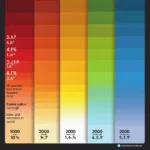Have you ever pulled out a slice of bread, only to find a fuzzy surprise? Mold on bread is a common occurrence, and while it’s definitely unappetizing, it also raises questions. One question that often comes up is, “What Color Is Mold On Bread?” While most people associate mold with the color green, the truth is that bread mold can appear in a range of hues, each indicating a different type of mold with its own characteristics.
Decoding the Rainbow of Bread Mold
Mold isn’t a single organism, but rather a diverse group of fungi. The color of mold on bread depends on the species of mold growing on it. Let’s take a closer look at the common culprits behind those colorful colonies:
1. Green Mold: Penicillium
Green is perhaps the most familiar color when it comes to mold on bread. This vibrant green hue is often a sign of Penicillium species, specifically Penicillium chrysogenum, a common bread mold. It starts as small white spots, then develops into fuzzy green patches as it matures. While some species of Penicillium are used to create the antibiotic penicillin, it’s important to remember that moldy bread is never safe to eat.
2. Black Mold: Rhizopus stolonifer
Black mold, often caused by Rhizopus stolonifer, is another common culprit. This type of mold appears as black spots that can develop a fuzzy texture. It thrives in warm, humid conditions and spreads rapidly. Black mold is not only visually unappealing but can also be harmful if ingested in large amounts.
3. Blue Mold: Penicillium roqueforti
Yes, blue mold can indeed appear on bread! Penicillium roqueforti, the same type of mold used to make blue cheese, can also grow on bread. It typically appears as blue-green spots or patches. While this mold is safe for consumption in cheese, it’s best to avoid eating it on bread, as it can still cause digestive upset.
4. White Mold: Various Species
White mold can be a bit trickier to identify as several types of mold can appear white, including early stages of Penicillium and Rhizopus. It often looks like a fluffy white coating on the bread’s surface. Regardless of the specific species, it’s crucial to discard any bread with white mold.
5. Other Colors: A Mix of Possibilities
While green, black, blue, and white are the most common colors of bread mold, you might encounter other shades as well. For instance, pink or orange mold could signal the presence of Neurospora species. Yellow or orange mold could be Aspergillus, and brown mold might indicate Cladosporium.
Why Does Mold Grow on Bread?
Mold spores are tiny, airborne particles that are everywhere in the environment. Bread provides an ideal breeding ground for these spores, especially when conditions are right. Here’s why:
- Moisture: Mold thrives in moist environments. Bread, especially if not stored properly, can retain moisture, creating an inviting habitat for mold spores.
- Nutrients: Bread is rich in carbohydrates, which mold uses as a food source to grow and reproduce.
- Warmth: Most mold species prefer temperatures between 77°F and 86°F (25°C and 30°C).
Preventing Mold on Bread
While seeing colorful mold on your bread is never a pleasant experience, the good news is that there are simple steps you can take to prevent it:
- Store bread properly: Keep bread in an airtight container or bag at room temperature. Avoid storing bread in the refrigerator, as this can actually accelerate staling and mold growth.
- Keep it dry: Ensure the bread storage area is dry and well-ventilated.
- Freeze for longer storage: If you don’t plan on eating bread quickly, freezing is a great way to preserve it and prevent mold growth.
When in Doubt, Throw It Out!
Remember, mold on bread is a clear sign of spoilage. Never attempt to salvage moldy bread by cutting off the moldy parts, as the mold’s microscopic roots (mycelia) may have already spread throughout the loaf. Consuming moldy bread can lead to food poisoning and other health issues. When it comes to mold on bread, it’s always better to be safe than sorry.
FAQs:
1. Is all bread mold dangerous?
While not all mold species are toxic, it’s impossible to determine the exact type of mold on your bread without laboratory testing. Therefore, it’s best to err on the side of caution and discard any moldy bread.
2. Can I still eat bread if I remove the moldy part?
No. Mold roots can spread invisibly throughout the bread, contaminating the entire loaf.
3. How long does it take for mold to grow on bread?
The time it takes for mold to grow on bread depends on various factors, including storage conditions and bread type. Generally, bread left at room temperature is more susceptible to mold growth than bread stored in the freezer.
4. What should I do if I accidentally eat moldy bread?
If you accidentally consume a small amount of moldy bread, don’t panic. Most people don’t experience any adverse effects. However, if you experience symptoms like nausea, vomiting, or diarrhea, consult a doctor.
Need More Help With Colors?
Do you have more questions about the fascinating world of colors? We’re here to help! Contact our team at 0373298888 or email us at [email protected]. You can also visit our office at 86 Cầu Giấy, Hà Nội. We’re available 24/7 to assist you with all your color inquiries.

